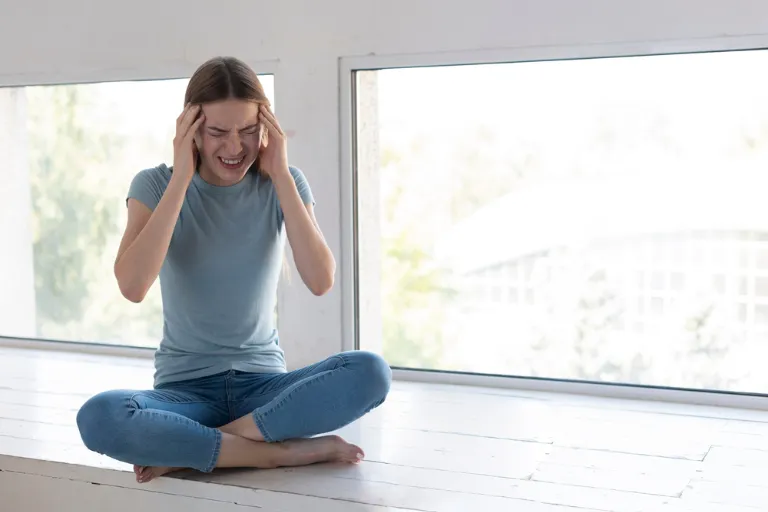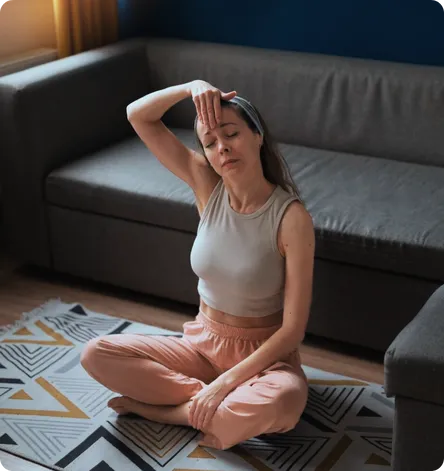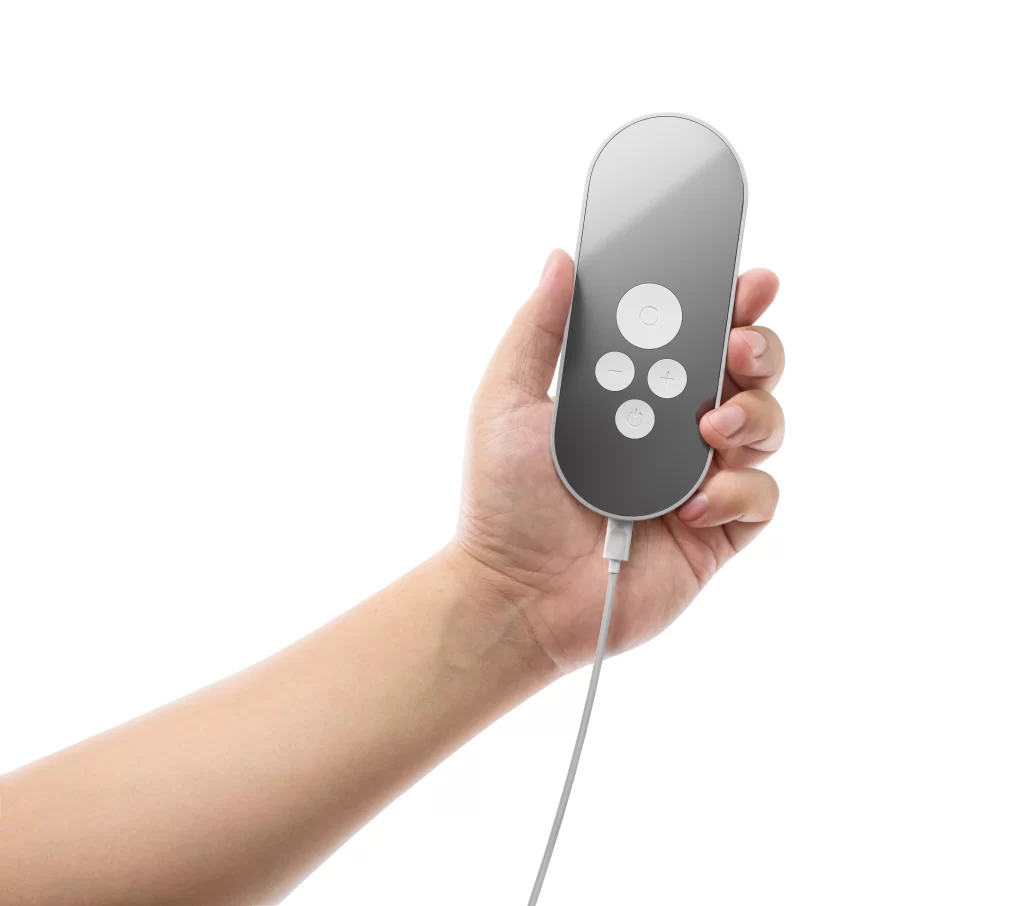If you’ve tried every mindfulness app and breathing technique but still feel anxious – it’s not your fault, and here’s the scientific reason why…

Why Mediation Fails For Anxious People (The 4 Facts About Mindfulness You MUST Know To Relax)
You shouldn’t feel like a failure because meditation doesn’t calm your racing mind.
Downloaded apps shouldn’t make you more frustrated with yourself.
Following guided breathing shouldn’t leave you feeling more anxious than before.
Sitting still with your thoughts shouldn’t feel like torture.
Here are 4 scientific reasons why meditation fails for chronic anxiety – and the breakthrough discovery that actually works when your nervous system is stuck in overdrive.
#1. Your Anxiety Is Too “Loud” for Meditation to Override

For months, you felt like a broken person because meditation made your anxiety worse instead of better.
Every app promised that 10 minutes of mindfulness would calm your racing thoughts, but you would sit there with your eyes closed while your brain screamed about deadlines, replayed embarrassing conversations from three years ago, and convinced you were definitely having a heart attack.
Then I learned about “arousal threshold” – basically, how activated your nervous system is at any given moment.
Think of your anxiety like a screaming fire alarm going off in your house.
Meditation is like trying to have a quiet phone conversation with your mom while that alarm blares at full volume right next to your ear.
The conversation (mindfulness) might be exactly what you need, but you literally cannot hear it over the noise (anxiety).
For people with mild stress, meditation works beautifully – their internal “volume” is low enough for gentle techniques to be effective.
But when you’re in chronic anxiety mode, your nervous system is operating at such high intensity that conscious breathing and mindfulness can’t access the deeper control centers.
It’s not that meditation is bad – it’s that your anxiety is too severe for meditation’s gentle approach.
You need something powerful enough to turn down the “volume” first, then meditation actually becomes possible.
You trying to meditate while anxious: “Just breathe… just breathe… WHY ISN’T THIS WORKING?!”
#2. Meditation Requires the Exact Brain Function That Anxiety Destroys

Here’s the cruel irony that no mindfulness teacher tells you: meditation requires sustained attention and emotional regulation – the exact mental capabilities that anxiety systematically dismantles.
It’s like being told to use a ladder to escape a flooding basement, but the flood has already washed the ladder away.
When you’re anxious, your prefrontal cortex (the part of your brain responsible for focus and rational thinking) goes offline. Your amygdala (fear center) takes over and scatters your attention in every direction looking for threats.
Meditation apps cheerfully instruct you to “focus on your breath” when anxiety has literally disabled your ability to focus on anything for more than 3 seconds. You sit there trying to count breaths – “One… two… wait, did I lock the front door? What if that text from my boss means I’m getting fired? One… no, was I on two? Why can’t I do this simple thing?”
You’re being asked to use a mental muscle that anxiety has temporarily paralyzed.
This creates a frustrating cycle: you need calm focus to meditate successfully, but you need to meditate successfully to achieve calm focus.
It’s not a character flaw – it’s basic neuroscience. Your brain in anxiety mode simply cannot execute the cognitive tasks that meditation requires.
You need a way to restore basic nervous system function first, then meditation becomes not just possible, but actually enjoyable.
#3. Your Nervous System Interprets “Sitting Still” as Danger (The Stillness Paradox)

This one blew my mind: for people with chronic anxiety, sitting still and “going inward” can actually trigger more anxiety, not less.
Your hypervigilant nervous system interprets stillness as vulnerability – like a prey animal stopping to rest while predators might be nearby.
In nature, animals only relax when they’re absolutely certain the environment is safe. Your anxious nervous system never gets that “all clear” signal, so forced stillness feels threatening instead of peaceful.
Think about it: when you’re anxious, do you naturally want to sit quietly with your thoughts?
Or do you want to move, pace around the kitchen, reorganize your closet, scroll through your phone, fold laundry – anything to avoid being trapped alone with that buzzing, uncomfortable energy crawling under your skin?
Your nervous system is trying to keep you moving because it thinks you’re in danger.
Meditation asks you to do the opposite of what your survival instincts are screaming at you to do.
This is why so many anxious people report that meditation makes them feel “trapped,” “agitated,” or “more aware of how bad they feel.”
It’s not that you’re “bad at meditation” – your nervous system genuinely perceives the meditation posture as risky.
You need to signal safety to your nervous system first, then stillness becomes naturally appealing instead of threatening.
#4. Meditation Works on the “Software” But Your Problem Is in the “Hardware”

Here’s the technical explanation that changed everything for me: meditation works at the cognitive level (thoughts and awareness), but chronic anxiety is primarily a nervous system hardware problem.
It’s like trying to fix a computer that keeps crashing by changing the screensaver – you’re working on the wrong layer entirely.
Meditation teaches you to observe anxious thoughts without getting caught up in them. That’s valuable for people whose anxiety is primarily psychological.
But for chronic anxiety sufferers, the problem isn’t the thoughts themselves – it’s that your nervous system is stuck in a biological state that automatically generates anxious thoughts 24/7.
Your vagus nerve (the main “calm down” nerve) has become so weak that it can’t override your sympathetic nervous system (fight-or-flight mode).
No amount of mental techniques can fix a biological malfunction.
It’s like having a car with faulty brakes and trying to stop by gripping the steering wheel harder and visualizing the car slowing down. The problem isn’t your mental focus – it’s that the actual brake pads are worn out and need replacing.
Meditation is an excellent tool for mental hygiene, but it can’t repair damaged nervous system hardware.
You need direct intervention at the biological level first, then meditation actually has something to work with.
What Actually Works When Meditation Fails
After trying 47 different meditation apps (yes, some of us counted), you discovered something that changed everything: targeted electrical stimulation of the vagus nerve.
Instead of trying to think your way out of anxiety, you could directly activate the biological system responsible for calm.
It’s like having a master key that unlocks your nervous system’s natural relaxation response – no meditation skills required.
Something that could target your vagus nerve through precise electrical pulses delivered via your ear.
Within minutes, you could feel your nervous system downshifting from high alert to genuinely calm – something months of meditation had never achieved.
Here’s what made it different:
- Worked immediately – no learning curve or practice required
- Didn't require focus – could watch TV or work while using it
- Actually lowered the "volume" – made meditation possible for the first time
- Fixed the hardware – restored my nervous system's ability to self-regulate
Why This Approach Solves All 4 Meditation Problems
- Problem #1: Direct electrical stimulation is powerful enough to override high anxiety states
- Problem #2: Works automatically without requiring focus or attention skills
- Problem #3: Can be used while moving around and staying active
- Problem #4: Targets the biological hardware that generates anxiety, not just the mental software
Meet Nurosym™ – The Meditation Alternative That Actually Works for Anxiety

Nurosym™ is a CE-certified medical device that delivers targeted electrical stimulation to your vagus nerve through a comfortable ear clip.
Unlike meditation, it doesn’t require any mental effort, focus, or sitting still – it works automatically while you go about your normal activities.
Developed through 50+ clinical studies, Nurosym™ represents what many anxious people have been searching for: a way to access deep calm without having to “earn it” through perfect meditation practice.
How It Works (No Mental Effort Required)
- Clip and Go
Attach the small device to your ear – takes 10 seconds, completely comfortable - Automatic Activation
Gentle electrical pulses activate your vagus nerve directly, bypassing conscious effort - Nervous System Shift
Your body naturally downshifts from fight-or-flight to rest-and-digest mode - Natural Calm
Experience the deep relaxation that meditation promises but couldn’t deliver
The Clinical Evidence
- 50+ peer-reviewed studies from Harvard, UCLA, and Yale
- 61% increase in vagus nerve activity within just 5 minutes
- 2-4x more effective than breathing exercises alone
- 4 million user sessions with zero serious adverse events in studies to date
- 1,000+ healthcare professionals using it clinically
They Also “Failed” at Meditation But…

“I tried so many meditation apps but could never quiet my mind. My anxious thoughts would just get louder when I tried to sit still. With Nurosym, I actually feel my nervous system calming down automatically.”
– Sarah, Former meditation skeptic

“What I have noticed when I started using Nurosym is that it instantly soothes my nervous system. It’s not like meditation where you have to work at it – it just gradually calms you down.”
– Derek, Anxiety sufferer

“I felt like such a failure because meditation made my anxiety worse. Finally, something that actually works without requiring me to be ‘good’ at relaxing.”
– Michael, Busy professional
Perfect for People Who Struggle with Traditional Meditation
- Can't sit still – use while walking, working, or doing chores
- Racing mind – works without requiring mental focus
- Time constraints – 30 minutes while multitasking beats 20 minutes of dedicated meditation
- Meditation anxiety – no pressure to "do it right"
- Inconsistent practice – works immediately every time, no building skills required
Finally, An Alternative to Meditation That Actually Works

You can solve your anxiety without having to become a meditation master… Or get every penny of your money back.
For too long, you’ve been told that meditation is the “right” way to manage anxiety – downloading app after app, setting timers for 10 minutes of “mindful breathing,” and feeling like a failure every time your mind wanders after 30 seconds.
You could finally stop forcing yourself through frustrating meditation sessions and start directly fixing your nervous system instead.
Imagine feeling genuinely calm without having to earn it – no more sitting cross-legged fighting with your racing thoughts, no more guilt about skipping your “daily practice,” no more wondering why everyone else seems to find peace while you just feel more agitated.
Your order is completely protected by our bulletproof 30-day money-back guarantee.
That’s a full month to experience what happens when you work with your nervous system directly instead of trying to meditate your way around it.
If you don’t experience better anxiety relief than any meditation app has ever provided, we’ll refund every single dollar with no questions asked – that’s our promise to you.
You have absolutely nothing to lose, and finally…
You can stop feeling guilty about “failing” at meditation and start succeeding at actually being calm.
Click the button below to check availability now.
The article does not in any way constitute as medical advice. Please seek consultation with a licensed medical professional before starting any treatment. This website may receive commissions from the links or products mentioned in this article.
Share via:



